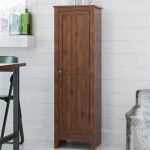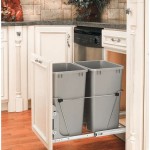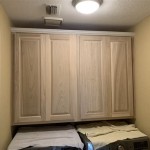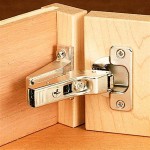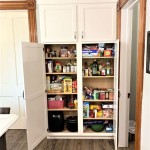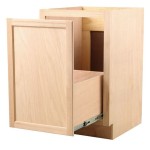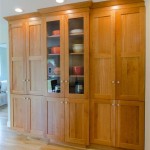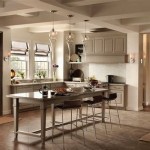What Are The Parts Of A Kitchen Cabinet?
Kitchen cabinets are fundamental components of any kitchen, providing storage, functionality, and aesthetic appeal. Understanding the various parts of a kitchen cabinet is essential for planning a remodel, performing repairs, or simply maintaining the longevity of your existing cabinetry. Each part plays a specific role in the overall structure and operation of the cabinet.
Cabinets are generally divided into two primary categories: base cabinets and wall cabinets. Base cabinets sit on the floor and support countertops, while wall cabinets are mounted on the wall. While they share many of the same constituent parts, their sizes, dimensions, and specific features can vary considerably.
This exposition will detail the standard components of both base and wall kitchen cabinets, offering insights into their construction and purpose.
Cabinet Box Construction
The cabinet box forms the structural foundation of the entire cabinet. It is typically constructed from plywood, particleboard (also known as furniture board), or medium-density fiberboard (MDF). The quality of the materials used significantly impacts the cabinet's durability and longevity. Plywood is generally considered superior due to its strength and resistance to moisture, followed by MDF, which offers a smooth surface for painting. Particleboard is a more budget-friendly option but is more susceptible to water damage and less structurally sound.
The cabinet box is composed of several key parts:
Sides: The side panels are the vertical supports that define the width of the cabinet. They are typically made from ¾-inch thick material and are responsible for bearing a significant portion of the cabinet's weight.
Bottom: The bottom panel provides a horizontal surface for supporting stored items within the cabinet. Like the sides it is generally constructed of ¾-inch material, especially in base cabinets to handle weight. In wall cabinets, it may sometimes be thinner.
Top: In base cabinets, the top is often absent, as the countertop serves as the top surface. However, some base cabinets, particularly those designed for specific appliances or with integrated features, may have a partial or full top. Wall cabinets always have a top panel, completing the box's structure and providing a surface for mounting hardware.
Back: The back panel provides structural rigidity to the cabinet box and helps to keep it square. It can be made from various materials, including plywood, hardboard (also known as pegboard), or even thinner particleboard. A full back panel strengthens the cabinet and simplifies installation by providing a solid surface for attaching to the wall. Some cabinets may have a partial back panel, typically a rail or frame, which may reduce cost but offer less structural support.
Frame (Face Frame vs. Frameless): The cabinet box may feature either a face frame or a frameless (also known as European-style) construction. A face frame is a solid wood frame attached to the front of the cabinet box. This frame provides additional strength and a surface for attaching doors and drawer fronts. It also gives the cabinet a more traditional look. Frameless cabinets, on the other hand, lack a face frame. The doors and drawer fronts are attached directly to the edges of the cabinet box. This offers a more modern and streamlined appearance and maximizes interior storage space.
Toe Kick (Base Cabinets): The toe kick is a recessed area at the bottom of base cabinets that allows you to stand comfortably at the countertop without bumping your toes. It is typically around 4 inches high and 3 inches deep. The toe kick can be a separate piece attached to the cabinet box or an integral part of the cabinet's construction.
Doors and Drawers
Cabinets would be functionally incomplete without doors and drawers. These components provide access to the interior storage space and contribute significantly to the overall aesthetic of the kitchen.
Doors: Cabinet doors are hinged panels that swing open to reveal the cabinet's contents. They are available in a wide variety of styles, materials, and finishes. Common door styles include raised panel, recessed panel, slab, and shaker. Door materials can range from solid wood to wood veneer, laminate, or even glass. Doors are attached to the cabinet box using hinges.
Door Hinges: Hinges are crucial for the proper functioning of cabinet doors. They allow the door to swing open and closed smoothly and securely. There are several types of hinges available, including:
- Standard Hinges: These are the most common type of hinge. They are typically visible when the door is closed.
- Concealed Hinges: Also known as European hinges, these hinges are hidden when the door is closed, providing a clean and contemporary look. They also often offer adjustability, allowing you to fine-tune the door's alignment.
- Self-Closing Hinges: These hinges automatically close the door when it is within a certain range of the cabinet box. They help to prevent doors from being left ajar.
- Soft-Close Hinges: These hinges slow the door down as it closes, preventing it from slamming shut. They offer a more luxurious and quiet operation.
Door Handles and Knobs: These hardware pieces provide a grip for opening and closing the cabinet doors. They are available in a vast range of styles, materials, and finishes, allowing you to customize the look of your cabinets.
Drawers: Drawers are sliding compartments that provide convenient access to stored items. They are typically used for storing utensils, cookware, and other smaller items. A drawer consists of several parts:
Drawer Box: The drawer box is the structural container of the drawer, typically constructed from wood or metal. The drawer box consists of the following parts:
- Drawer Front: The drawer front is the visible face of the drawer. It is attached to the front of the drawer box and matches the style and finish of the cabinet doors.
- Drawer Sides: The drawer sides are the vertical panels that define the width of the drawer box.
- Drawer Back: The drawer back is the vertical panel that forms the rear of the drawer box.
- Drawer Bottom: The drawer bottom is the horizontal panel that supports the contents of the drawer. It can be made from plywood, particleboard, or MDF.
Drawer Slides: Drawer slides are mechanisms that allow the drawer to slide smoothly in and out of the cabinet. There are several types of drawer slides available, including:
- Roller Slides: These slides use rollers to facilitate movement. They are a more basic and economical option.
- Ball-Bearing Slides: These slides use ball bearings for smoother and quieter operation. They can generally handle more weight than roller slides.
- Soft-Close Slides: Similar to soft-close hinges, these slides slow the drawer down as it closes, preventing it from slamming shut.
- Full-Extension Slides: These slides allow the drawer to be pulled out completely, providing access to the entire contents of the drawer.
Drawer Pulls: These are the handles used to pull the drawers open. They are often paired in style and finish with the door handles or knobs.
Interior Components and Accessories
The interior of a kitchen cabinet can be customized with various components and accessories to enhance organization and functionality.
Shelves: Shelves provide horizontal surfaces for storing items within the cabinet. They can be adjustable or fixed. Adjustable shelves offer flexibility in configuring the storage space to accommodate items of different sizes. Shelves are typically made from plywood, particleboard, or MDF. They are supported by shelf supports, which can be either metal clips or small pegs inserted into pre-drilled holes in the cabinet sides.
Rollout Trays: Rollout trays, also known as pull-out shelves, are shelves that slide out of the cabinet, providing easy access to items stored in the back. They are particularly useful in base cabinets for storing pots, pans, and other bulky items. Rollout trays are installed on drawer slides.
Lazy Susans: Lazy Susans are rotating shelves that are typically installed in corner cabinets to maximize storage space and accessibility. They allow you to easily reach items stored in the back of the cabinet without having to reach deep inside.
Spice Racks: Spice racks are specialized storage units designed for organizing spices. They can be mounted on the inside of cabinet doors or walls, or they can be freestanding.
Wine Racks: Wine racks are designed for storing wine bottles. They can be integrated into cabinets or freestanding units.
Trash Pullouts: Trash pullouts are cabinets with a built-in waste container that slides out for easy disposal. They help to keep the kitchen clean and organized.
Cabinet Lighting: Integrated lighting can significantly enhance the functionality and aesthetics of kitchen cabinets. Under-cabinet lighting provides task lighting for countertops, while interior cabinet lighting illuminates the contents of the cabinet.
Understanding these component parts provides a deeper comprehension of cabinet construction and facilitates informed decisions during the design, purchase, installation, or repair processes. Each element contributes to the overall functionality, durability, and aesthetic appeal of the kitchen cabinetry.

Cabinet Parts And Profiles

Kitchen Cabinet Parts Names Google Search Plans Cabinets Design

Kitchen Cabinet Terms Cabinets Of The Desert

How To Choose Kitchen Cabinets When Remodeling

The Abcs Of Kitchen Cabinets Part 2 Akg Design Studio

Everything You Need To Know About Kitchen Cabinets Rona

The Carlisle Series Cabinet Specifications

Cabinetry Terms With Pictures A Guide To Understanding Kitchens

How To Build Cabinets The Complete Guide Houseful Of Handmade

Cabinetapp Is Meant To Serve Purchasers Who Have A Background And Sufficient Knowle Hanging Kitchen Cabinets Refacing Cost Of
Related Posts

